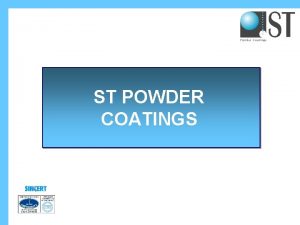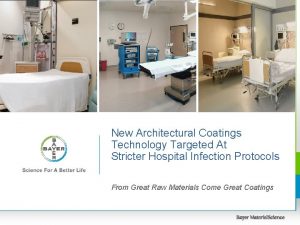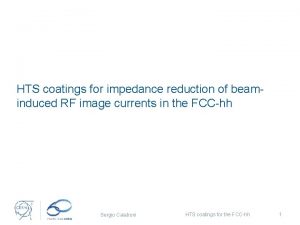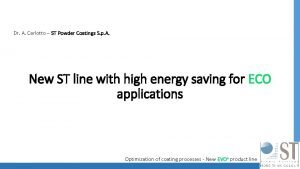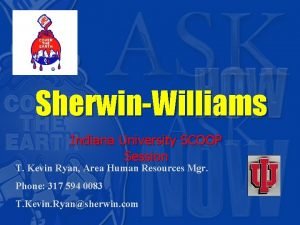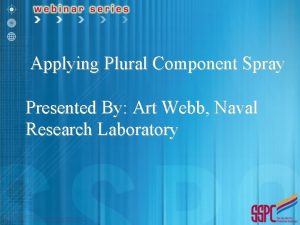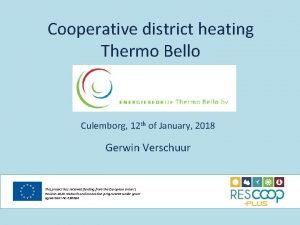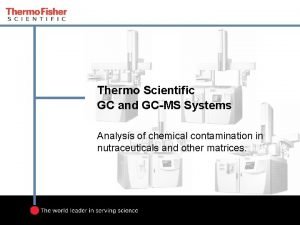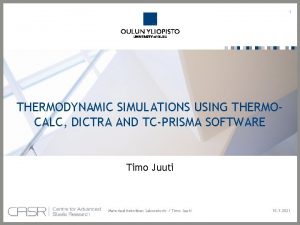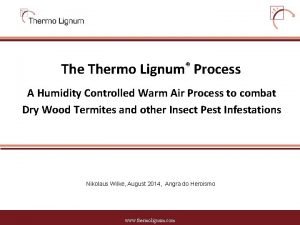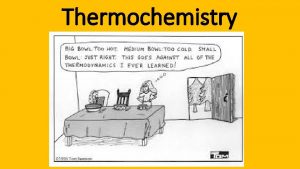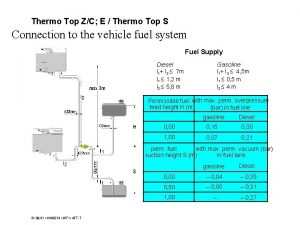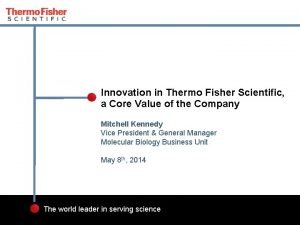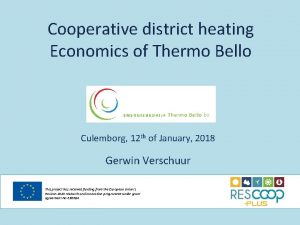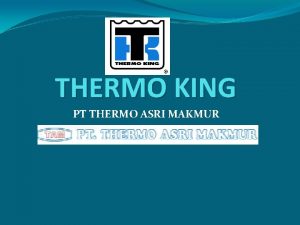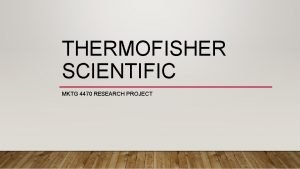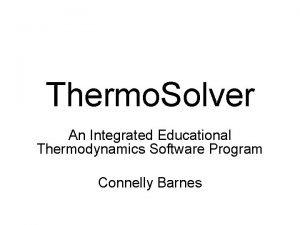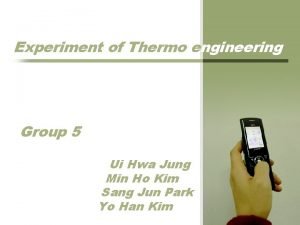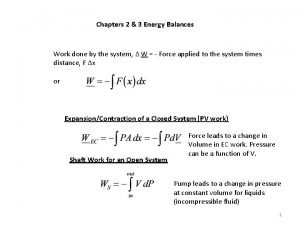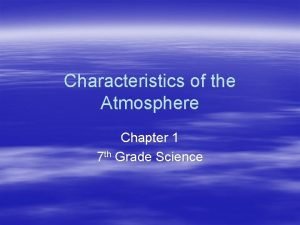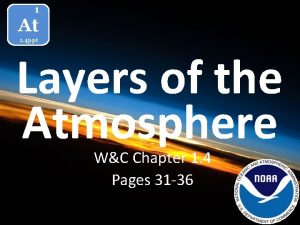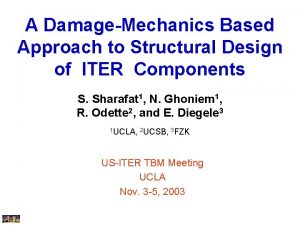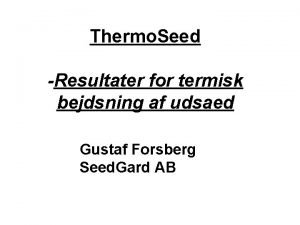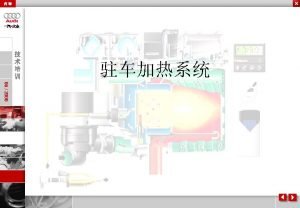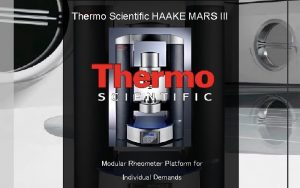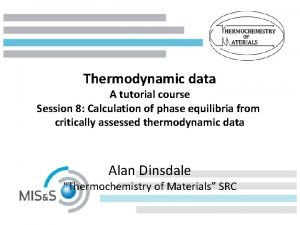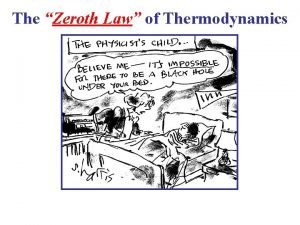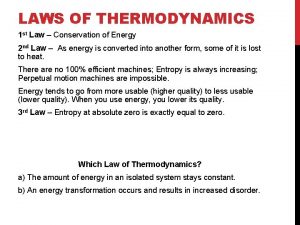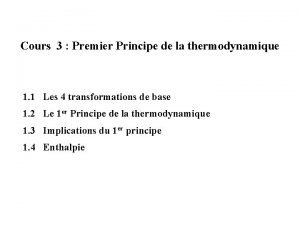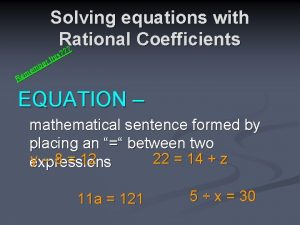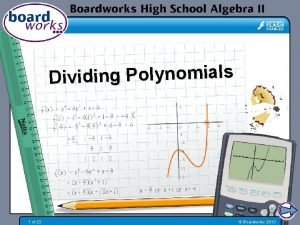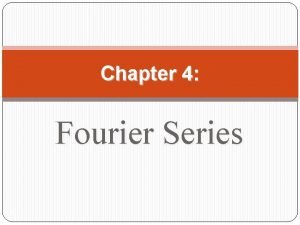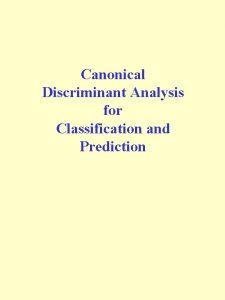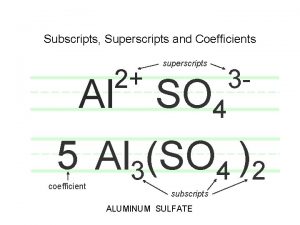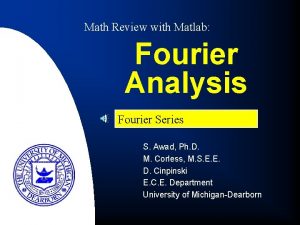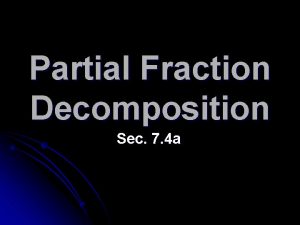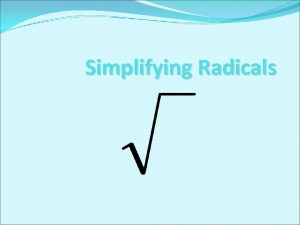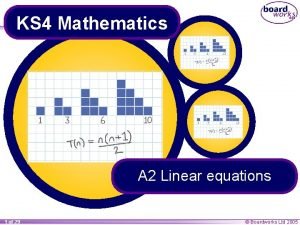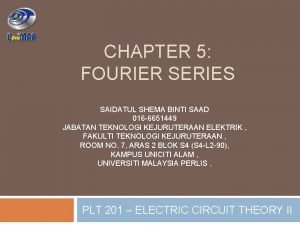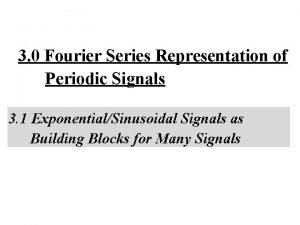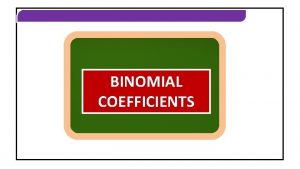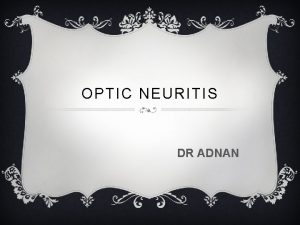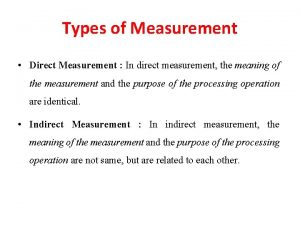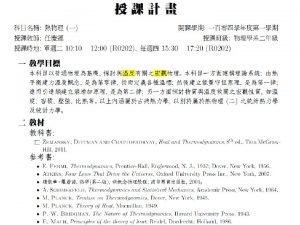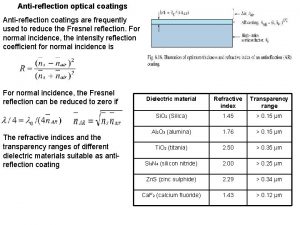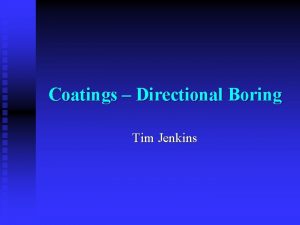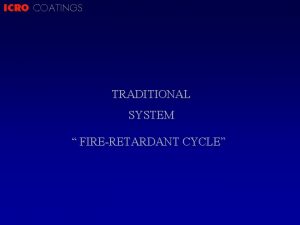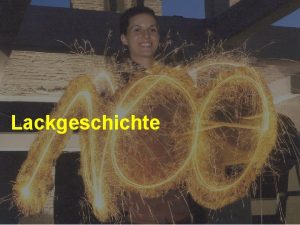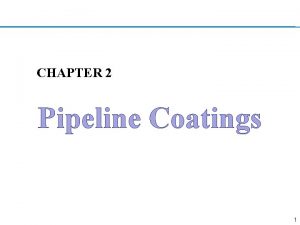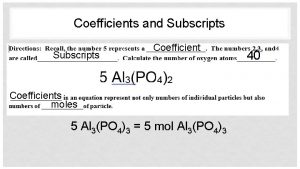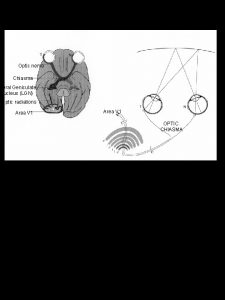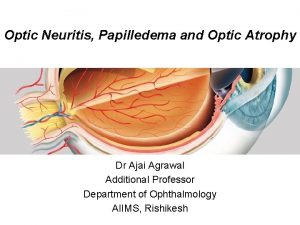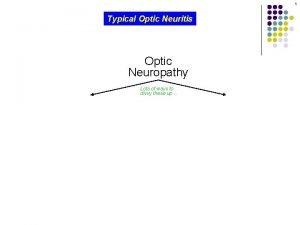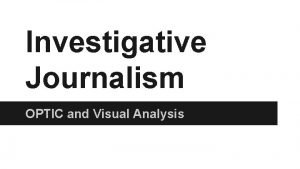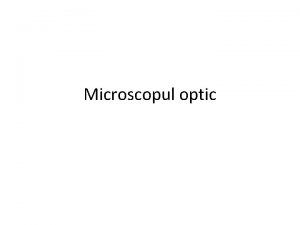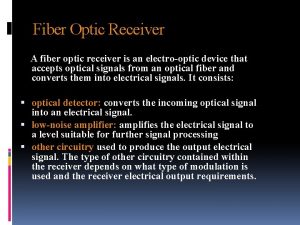Direct Measurement of Thermo Optic Coefficients in Coatings


















































- Slides: 50

Direct Measurement of Thermo. Optic Coefficients in Coatings by Photothermal Spectroscopy Greg Ogin, Eric Black, Eric Gustafson, Ken Libbrecht Matt Abernathy Presenting LSC/VIRGO Conference, Rome, Italy, 10 September 2012 LIGO-G 1200935 1

The Ad. LIGO Noise Curve Source: Evans et al, LIGO-P 080071 -00 2

Thermo-optic Noise: TO = TE + TR • Thermo-Elastic (TE): Mirror’s surface expands into probe beam. By convention, negative dφ/d. T 3

Thermo-optic Noise: TO = TE + TR • Thermo-Refractive (TR): Coating layers deviate from λ/4 condition – due to both physical expansion and change in index of refraction. To first order, this manifests as a change in the phase of the reflected beam. E+ Quarter-wave stack: EE+ After expansion, index change: E 4

Photothermal Apparatus NPRO Test Mirror CO 2 Vacuum Chamber AOM λ/2 Beam Dump PBS λ/2 PZT Beam Dump Fringe Locking Electronics Data Acquisition Electronics 5

Mirror Under Test 6

Expected Signal: Canonical Form Substrate CTE 7

Expected Signal: Canonical Form Substrate CTE Coating properties (including coating CTE effects) 8

Sapphire Substrate Response Magnitude 9

Sapphire Substrate Response Phase 10

Silica Substrate Response Magnitude 11

Silica Substrate Response Magnitude +/- 20% 12

Recent Results: Silica Substrate 13

Combined TE/TR Results • QWL • Bragg 14

Gold coatings for pure TE measurements Challenge: 80% CO 2 absorption drops down to 0. 5% CO 2 absorption. 15

Much lower SNR Displacement (m) 10 -11 10 -12 16

Gold Coated “TE alone” Results • QWL • Bragg 17

Extracting Values For quarter-wavelength coatings For 1/8 -3/8 coatings For quarter-wavelength TE only (Cr? Chromium. ) For 1/8 -3/8 coatings TE only 18

The Measurement Matrix Which we invert to get… 19

The Parameter Estimation Matrix 20

Our Results… 21

Our Measurements of α Si. O 2 – Low Index • 2. 1 x 10 -6 K-1 – Cetinorgu et al, Applied Optics 48, 4536 (2009) • 5. 1 x 10 -7 K-1 – Crooks et al, CQG (2004) • 5. 5 x 10 -7 K-1 – Braginsky et al, Phys Lett A 312, 244 (2003) (5. 5 ± 1. 2)x 10 -6 K-1 • • Ta 2 O 5 – High Index + 4. 4 x 10 -6 K-1 – Cetinorgu et al, Applied Optics 48, 4536 (2009) + 3. 6 x 10 -6 K-1 – Crooks et al, CQG (2004) - 4. 4 x 10 -5 K-1 – MN Inci, J Phys D 37, 3151 (2004) + 5 x 10 -6 K-1 – Braginsky et al, ar. Xiv: grqc/0304100 v 1 (2003) (8. 9 ± 1. 8)x 10 -6 K-1 22

Our Measurements of β Si. O 2 – Low Index • 8 x 10 -6 K-1 – GWINC v 2 (“Braginsky”) (1. 9 ± 8. 0)x 10 -6 K-1 Ta 2 O 5 – High Index • 1. 21 x 10 -4 K-1 – MN Inci, J Phys D 37, 3151 (2004) • 6 x 10 -5 K-1 * – Gretarsson, LIGO-G 080151 -00 -Z (2008) *Assumes α (1. 2 ± 0. 4)x 10 -4 K-1 23

Ad. LIGO Baseline (GWINC v 3) 24

Ad. LIGO with Our Parameters Disclaimer: This Is Not an Ad. LIGO Prediction 25

Conclusions • Measuring these parameters is non-trivial, but we have demonstrated a technique, and reported initial results • We have the ability to measure exactly what Ad. LIGO needs • Thermo-optic noise, and these parameters in particular, could be critical and need further study for future generations of gravitational wave detectors 26

Future Directions • Characterize and reduce systematic errors • Perform measurements on Ad. LIGO coatings with Cr layers (or at the very least Ion Beam Sputtered coatings and Ti: Ta 2 O 5 coatings) • Look at measurements of other materials and geometries 27

Acknowledgements • • • Greg Ogin Ken Libbrecht, Eric Black Eric Gustafson Caltech LIGO-X, Akira Villar Family and friends LIGO and the NSF – Award PHY-0757058 28

Questions? 29

Supplimentary Slides follow 30

Measuring α: Cavity Assisted Photothermal Spectroscopy • Probe locked to cavity • Pump derived from probe laser chopped to cyclically heat cavity end mirror • Sensitivity to mirror expansion proportional to Finesse • Heating power in cavity proportional to Finesse • Sample coated with gold to enhance absorption Black et al, J Appl Phys 95, 7655 (2004) 31

Details of the two terms: • Thermo-Elastic: Negative phase • Thermo-Refractive: Positive phase Evans et al, Physical Review D 78, 102003 (2008) 32

Theory: Assumptions • The scale of periodic thermal disturbances (a “thermal wavelength”) is much smaller than our heating spot • The coating thickness is smaller than a thermal wavelength Together, these give us a 1 -D problem where thermal dynamics are all determined by the properties of the substrate. 33

Theory: Heat Equation Solutions • The heat equation becomes • With solutions 34

Theory: Boundary Condition • Our boundary condition gives C(ω) 35

Expected Signal A Coherent Sum of… 36

Expected Signal: Canonical Form 37

(Reminder) • Thermo-Elastic: Negative phase • Thermo-Refractive: Positive phase Evans et al, Physical Review D 78, 102003 (2008) 38

Expected Signal: Canonical Form 39

Expected Signal: Canonical Form 40

Expected Signal: Canonical Form 41

Expected Signal: Canonical Form 42

Recent Results: Sapphire Substrate Response Magnitude 43

Recent Results: Sapphire Substrate Response Phase 44

Recent Results: Sapphire Substrate Response Phase Wait, what? ! ? 45

Sapphire: Long Thermal Wavelength really means we have a 3 -D problem (axially symmetric), “plane thermal waves” don’t work 46

“Cerdonio”-type solution • Green’s function on the surface of a halfspace • Forced sinusoidally with a Gaussian profiled beam 47

Then all you have to do is… • Integrate • and again. 48

Thanks Mathematica 49

Thanks Mathematica 50
 Powder coating kildare
Powder coating kildare Hospital wall coatings
Hospital wall coatings Kale group
Kale group Hts coatings
Hts coatings St powder coatings
St powder coatings Epoxy phenalkamine coatings
Epoxy phenalkamine coatings Alocit
Alocit Sherwin williams chemical coatings store
Sherwin williams chemical coatings store Plural component spray
Plural component spray Ascoli thermo precipitation test
Ascoli thermo precipitation test Thermo bello
Thermo bello Thermo
Thermo Tc-prisma
Tc-prisma Keylwerth-diagramm
Keylwerth-diagramm Prefix of thermo
Prefix of thermo Envirotuff roof insulation
Envirotuff roof insulation Thermo top z/c
Thermo top z/c Thermo fisher core values
Thermo fisher core values Bello heating and cooling
Bello heating and cooling Pt thermo asri makmur
Pt thermo asri makmur Thermofisher mission statement
Thermofisher mission statement Ql qh thermo
Ql qh thermo Thermo solver
Thermo solver Thermo engineering
Thermo engineering Thermo
Thermo Tropo strato meso thermo exo
Tropo strato meso thermo exo Thermo chromeleon
Thermo chromeleon Tropo strato meso thermo exo
Tropo strato meso thermo exo Thermo-mechanical fatigue
Thermo-mechanical fatigue Thermo seed
Thermo seed Thermo bello
Thermo bello Haake mars iii rheometer
Haake mars iii rheometer Ttrs
Ttrs Intelligaire iii
Intelligaire iii Zeroth law of thermo
Zeroth law of thermo Three laws of thermodynamics
Three laws of thermodynamics Principe 1 de la thermodynamique
Principe 1 de la thermodynamique Solving equations with rational coefficients
Solving equations with rational coefficients Equating coefficients
Equating coefficients 1 variable equations worksheet
1 variable equations worksheet Fourier series
Fourier series Discriminant analysis in spss
Discriminant analysis in spss Chemical formula subscript
Chemical formula subscript Matlab fourier series
Matlab fourier series Fraction decomposition
Fraction decomposition Dfs coefficients
Dfs coefficients Can you multiply radicals
Can you multiply radicals Solving equations with fractional coefficients
Solving equations with fractional coefficients Collect like terms
Collect like terms Fourier phase
Fourier phase Fourier series
Fourier series
